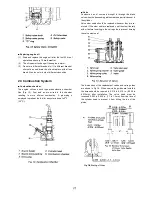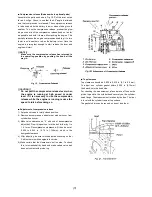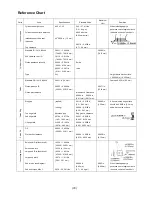
(5)
♦
♦
♦
♦
Fuel injection nozzle
The fuel injection nozzle, like the fuel injection pump, is also
a precision piece of equipment and should be treated with the
same amount of care.
♦
♦
♦
♦
The nozzle cracking pressure
The nozzle cracking pressure is adjusted by adding or
subtracting shims from the top of the nozzle spring. Adding a
0.004in. (0.1mm) shim will increase the cracking pressure by
about 142 psi. (10 kg/cm
2
). The nozzle cracking pressure is
1990 to 2133 psi. (140 to 150 kgf/cm
2
)
♦
♦
♦
♦
Spray pattern
The nozzle cracking pressure and fuel spray pattern are most
accurately checked by using a nozzle “pop test” stand. If a
“pop test” stand is not available, remove the nozzles from the
engine, leaving the pressure lines connected.
[[ CAUT ION ]]
Hold nozzles so that the high pressure spray from them
will not in any way impinge upon unprotected skin. The
atomized fuel will easily penetrate the skin and cause
blood poisoning.
Set the speed control lever at W. 0. T. and operate the
starter. The needle valve, if it is working properly, will
produce a high pitched pulsating sound like that of a flute as
fuel is sprayed out. If this sound is not heard or other
problems are noted, refer to the “Fuel Injection Pump &
Nozzle Maintenance Std.” in 4.1 in “Engine”.
[[ Precaution ]]
(1) Assembly and disassembly of the nozzle should be
done in fresh clean fuel
(2) The nozzle should always be installed as an
assembly, never by component parts
(3) Remember never to let the nozzle spray contact
unprotected flesh
(4) Tighten the retaining nut to 43.5 to 58 ft-lb (6 to 8
kgf.m) Any torque higher than this will cause slow
action of the needle valve and poor injection.
2.2 Lubrication System
♦
♦
♦
♦
Oil pump pick-up screen
The oil pump pick-up is located in the crankcase as shown in
Fig. 9 and is fitted with a metal screen. If the screen becomes
plugged, wash it off with diesel fuel or kerosene.
♦
♦
♦
♦
Lubrication system
The entire lubrication system is illustrated in Fig. 8. Oil from
the pump is forced through the replaciable paper element
filter. The filter is equipped with a pressure regulated valve to
keep the pressure through the filter at 64— 71 psi. (4.5—5
kgf/cm
2
). From the filter part of the oil goes to the crankshaft
to lubricate the crankpins and the remainder goes to lubricate
the rocker arms.
An oil pressure switch is located in the passage from the filter
and controls the oil pressure. If the oil pressure falls below 14
psi. (1.0 kgf/cm
2
) the oil warning lamp will light on the dash
panel. If the oil pressure lamp stays on after the engine is
running at normal speed, shut the engine off immediately.
Find and correct the cause of the low oil pressure before
operating again.
If the pressure regulating valve in the filter fails and the
pressure rises, a safety valve will limit the pressure to 140
psi. (10 kgf/cm
2
)
Содержание Universal diesel 5416
Страница 21: ...19...








































